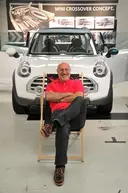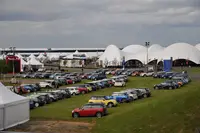Mini Fifty years - and not showing it!
Mini Specs, Prices and Comparisons-Mini Buyers Guide
 |
Senior European Editor
Amsterdam Bureau
Ther Auto Channel
SILVERSTONE, England. On August 26, Mini will be 50 years, but its birthday party already started by the end of May with the Mini United Festival. Location: the Silverstone Circuit, some 80 miles east of London, where the 3rd edition of the 3-day long Festival was organised.
Mini United was launched in 2005 in Misano, Italy, and again took place 2 years later at the Zandvoort race track in The Netherlands, where some 5,000 Mini’s united.
Expectations for this year’s birthday festival were high and Mini fans from all over the world did not let the organizers of their favourite brand down: around 25,000 fans came to Silverstone with old, new, customized or completely changed Mini models.
 |
 |
 |
 |
 |
Ongoing success
 |
In particular the small car project was important, due to the Suez Crisis, that had brought on petrol rationing.
Issigonis opted for front-wheel drive and the engine fitted crosswise at the front with the gearbox directly below, which formed the ideal conditions for optimal use op space of the 3.05 meters (120.0”) car.
After two prototypes were ready to go, Issigonis invited his boss Leonard Lord to a test drive. Issigonis later recalled that he drove around the plant: Ï was going like hell. I am certain he was scared, but he was very impressed by the car’s road holding. When we stopped outside hi office, he got out and simply said: “All right, build this car.”
The first Mini coming off the production line in Austin’s Longbridge plant, was an Austin Seven on April 4, 1959. Its twin brother, the first Morris Mini-Minor was completed in the Morris Oxford plant on May 8.
 |
 |
On October 4, 2000, after more nearly 5.4 million Mini’s had been built, production was discontinued.
Unexpected
In the meantime the BMW Group had taken over the Rover Group (1994), including the Mini. BMW invested around 280 million pounds in the Rover plant in Oxford in 1996/97 to modernise the body shop and the final assembly and the state-of-art paintshop.
 |
More investments were made to modernise and restructure the plant, adding up to another £ 230 million. In 1999 the Germans took the decision to build the modern Mini there. In 2000, Rover was still suffering massive losses and BMW decided to dispose of most of the company, to retain the Mini name and the planned new model. Rover was granted the temporary rights to the brand and allowed to manufacture and sell the run-out model of the old Mini.
After the last of the Mini production had been sold, the 'Mini' name reverted to BMW ownership. The new Mini (by BMW) was unveiled in Geneva in March 2001. BMW hoped to sell 100,000 cars a year, but that target was soon exceeded and the Oxford plant built 200,000 unites a year in 2005, a year after the Convertible had been added. The ongoing success made new investments of around £ 100 million necessary to prepare the plant for production of the second generation of the new Mini, increasing capacity to around 240,000 cars per year.
At the beginning of this year, Mini celebrated the 1.4-millionth unit of the modern model range.
 |



